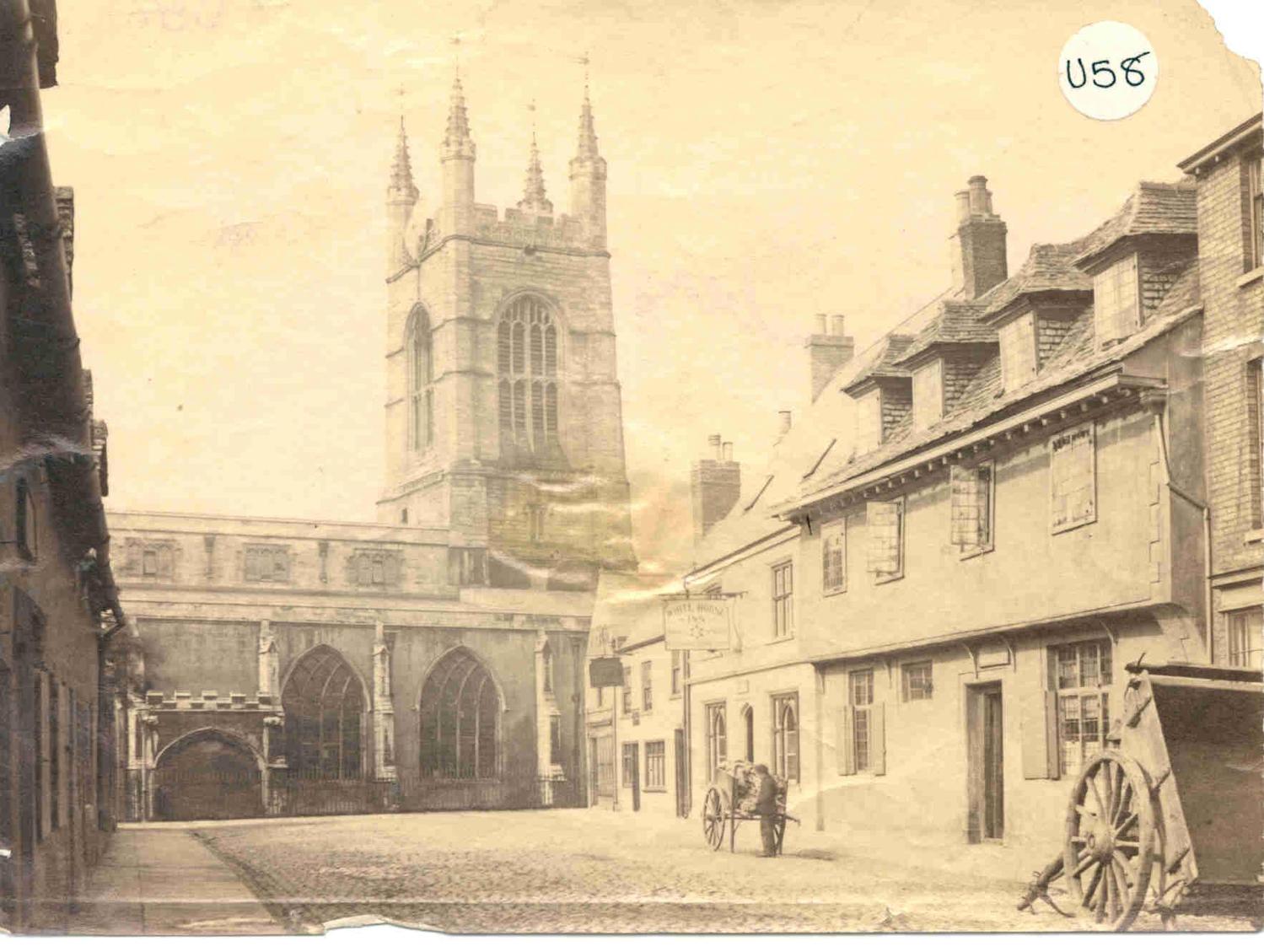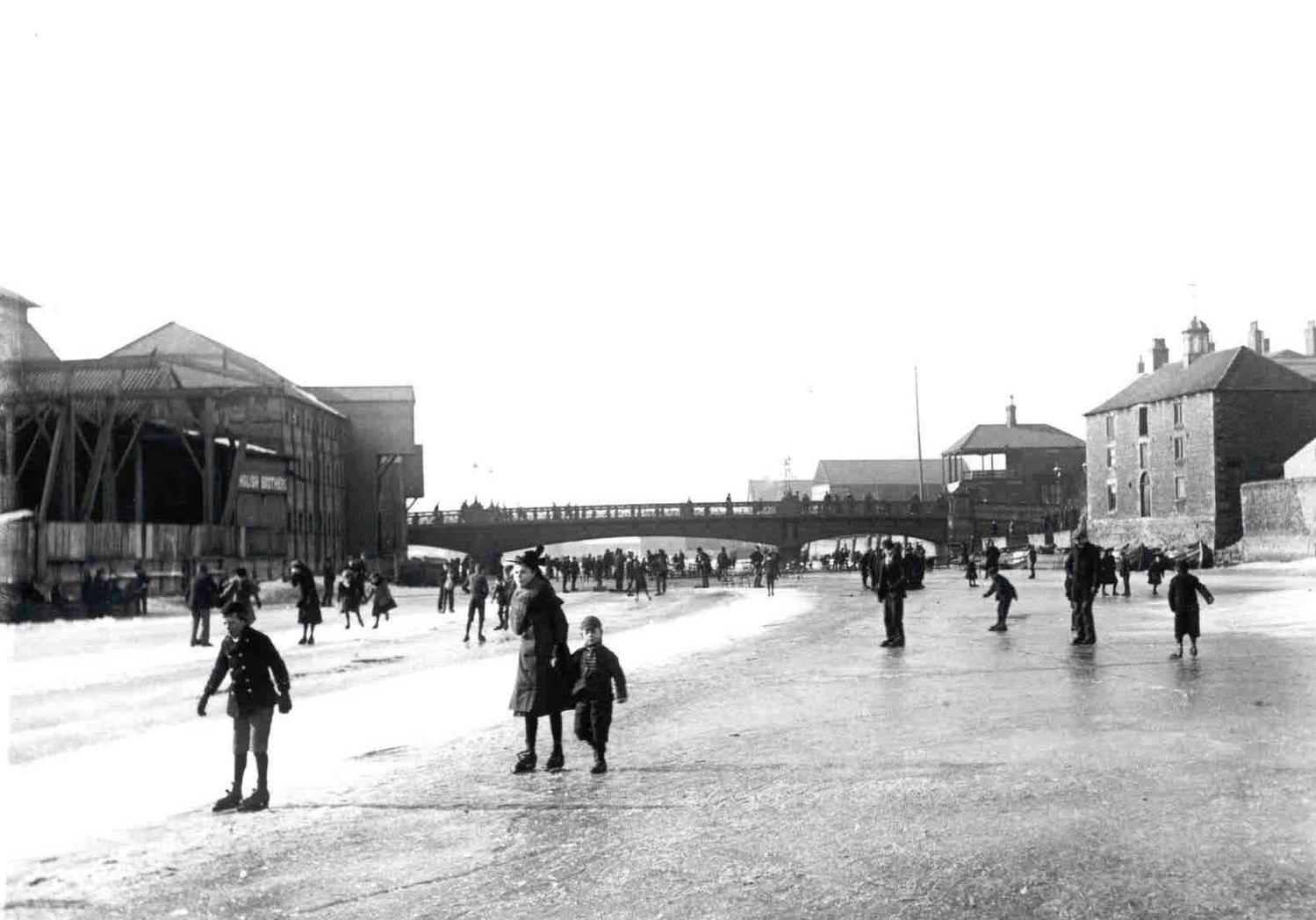Tragic Tales
Tuesday 24 October 2023
A look at some of the more disturbing and tragic stories from Peterborough's past
Was a Prince's Heart Placed in Peterborough Abbey's Well? 655-700
Simon Gunton wrote a book about the history of Peterborough Abbey/Cathedral in the seventeenth century. It featured a great many of the stories and details that have been passed down through the centuries and is a very important text on the history of the religious community and the city.
One of the stranger stories is from the early years of the abbey, when the settlement was known as Medeswell and sat in the land of Mercia. A religious community had been commenced on the orders of King Peada. On his death, his brother Wulfere or Wulfhere ruled the area, but he was not the devout Christian his brother was and had reverted back to paganism. His son, Prince Wulfade, was converted to Christianity by St Chad, convincing his brother Prince Rufine to do the same. They prayed in private but were discovered by a servant and reported to their father, who was so angry he killed them both and buried their bodies in the remains of the building they were praying in.

Their mother, Queen Ermenild or Ermenilda, searched for her boys and once she had discovered them, provided them with a proper burial. She became St Ermenilda of Ely, being the abbess there for many years. King Wulfhere was said to have been so distraught at his actions that he asked St Chad to convert him to Christianity to mend his ways and he was instrumental in continuing the building of the religious buildings in Medehamstede. It was said that the heart of Prince Wulfade was placed in the well in the cloister at the monastery by St Chad, with another account stating that Prince Wulfade had been baptised in the well by St Chad.
Unfortunately, the story of St Chad and the Mercian royal family appears to have taken place in another part of the country. Both princes were said to have been buried in what is now Staffordshire and Chad has no official connection with Medehamstede. Stained glass windows depicting the family’s story and Wulfhere’s construction of the abbey were placed in the south west windows of the abbey overlooking the cloister. It appears to have been no more than creative licence that associated Medehamstede Abbey with the story, either by design or by accident, for stories have a habit of changing over time. It’s very unlikely that Prince Wulfade’s heart ended up in the abbey well, or that he was baptised there, but it is well worth visiting it the next time you visit the Cathedral.
References:
Gunton, S. and Patrick, S., The History of the Church of Peterborough Wherein the Most Remarkable Things Concerning That Place, From the First Foundation Thereof, With Other Passages of History Not Unworthy Public View, Are Represented, (Richard Chiswell 1686; Text Creation Partnership 2011) pp. 2-4 http://name.umdl.umich.edu/A42... (accessed 27 April 2021)
Wulfhere of Mercia, Wikipedia, https://en.wikipedia.org/wiki/... (accessed 27 April 2021)
Peterborough Cathedral, In the Footsteps of Chad, (2016) https://peterboroughcathedral.wordpress.com/2016/05/30/in-the-footsteps-of-chad/
The Ailsworth Widow: Witch or Victim? 948
"The first records with the name of Ailsworth come from the 10th century in a charter granting property in Ailsworth to Bishop Athelwold, the Bishop of Peterborough. What is extraordinary about this record is the journey with which the land came into the hands of Wulfstan Uccea, who was granting the land to Bishop Aethelwold.
In 948 the property in Ailsworth was owned by a widow with a son: neither of them are ever named in the document. The lands had been removed from the widow when an effigy of Wulfstan’s father Alfsige had been found in her property with pins in it. We might recognise this as a form of voodoo nowadays, but the practice has been used for hundreds of years and was known as a form of witchcraft for which the stated punishment was extreme fasting for the perpetrator. However the widow was found guilty of being a witch and ‘taken and drowned at London Bridge’1. There are no specific details to this event and several people have debated the reason for her drowning and where indeed she actually died. One theory is that it was perhaps a mob reaction to the widow being identified as a witch, or perhaps she had been guilty of another crime not mentioned, which would have warranted the death penalty. Her son managed to escape and was described as an outlaw, which may suggest that it wasn’t a mob that caused her death.
As for the bridge, either the Great North Road (A1) or Peterborough have been suggested as locations with roads that head to London, although Peterborough did not gain a bridge until hundreds of years later. Stamford is another suggestion, which doesn’t work with modern boundaries (Stamford is in Lincolnshire), however it was one of the Five Boroughs, which made it a large and important centre, so it is possible that she was sent there for judgement. The hamlet of Ailsworth is less than a mile from the Nene and it possible that this was the location for her drowning, perhaps making use of the Roman Bridge, but we will never know. What is more telling is that the lands that the widow owned ended up in the hands of Alfsige, the man she was supposedly doing harm to. He gained a lot from her death, which makes it rather suspicious. Either way it makes for a fascinating insight into the lives and justice system of the 10th century in Peterborough.
References
A Rabin, Anglo-Saxon Women Before the Law: A Student Addition of Five Old English Lawsuits, Old English Newsletter, http://www.oenewsletter.org/OEN/print.php/essays/rabin41_3/Array
Hill, The Death of the Ailsworth Witch, Durobrivae: A Review of Nene Valley Archaeology, 1976, Vol 4, p 13, https://peterborougharchaeology.org/wp-content/uploads/2017/11/ailsworth-4-13.pdf
Destruction by King Sweyn of Denmark 1013
"In 1013 King Sweyn of Denmark, also known as Sweyn Forkbeard, was reported to have arrived in the area north of Peterborough. He had been at war with the country for the last twenty years and devised horrendously painful and humiliating deaths for some of his victims. Unsurprisingly, when he arrived in this area, he destroyed seven villages to the north of Peterborough and murdered or captured all of the inhabitants. The villages were Northborough, Maxey, Bainton, Helpston, Etton, Glinton and Maxey. Thankfully he died in Gainsborough in 1014 after being declared King for only 40 days, and the villages and places of worship were quickly restored.
References
A Lumley Prior, Heroes and Villains, Village Tribune, Issue 98 East, 2016, p 30-31 https://issuu.com/dimension6000/docs/vt_98_east_web
McKenna, Sweyn Forkbeard: England's Forgotten Viking King, BBC News, 2013, https://www.bbc.co.uk/news/uk-england-lincolnshire
A Monk Drowned in the Fens 1104
It is recorded in the Annals of the Abbey of Thorney that in this year a monk named Master Walter, and five servants, were shipwrecked and drowned in the mere called Saltana (a lake, now drained, probably south of Whittlesey).
Chronicle Writers (and a Wild Hunt) 1127
Much of the Anglo-Saxon Chronicle, our key source for early medieval English history, was written at Peterborough Abbey in this period – today preserved in the Peterborough D and E Manuscripts. Another chronicle was written here by a monk called Hugh Candidus, telling the story of the abbey. One tale he told was of a corrupt abbot, Henry d'Angély, who was a rather godless and worldly man who planned to loot Peterborough of its wealth. As a result a dread portent followed in the form of a spectral 'wild hunt' sent to terrorise the area. 'In the very year in which he came to the abbey, marvellous portents were seen and heard at night during the whole of lent, throughout the woodland and plains, from the monastery as far as Stamford. For there appeared, as it were, hunters with horns and hounds, all being jet black, their horses and hounds as well, and some rode as it were on goats and had great eyes and there were twenty or thirty together. Many men of faithful report both saw them and heard the horns...'
The Miracles of Lawrence of Oxford 1313
"A most peculiar story has survived from 1313 regarding a man known as Lawrence of Oxford. Records explain that he was hanged for 'evil crimes', and that miracles were taking place around his burial. What is intriguing is that he may have been buried in the Hospital of St Thomas the Martyr in the grounds of Peterborough Abbey, or at least in the burial ground of the hospital. When news reached residents of Peterborough, they started to flock to the site, happy to pay to receive a miracle. The monks were happy to profit from the situation too but, unsurprisingly, Bishop Dalderby, the presiding Bishop from Lincoln put a stop to such profiting from a criminal's demise, informing the monks that anyone who benefited from the situation would be excommunicated.
Sadly, nothing is else known about who Lawrence was, what his crimes were and how he ended up in Peterborough, but perhaps his remains are still in place and miracles are still happening..."
A Holiday from Hell 1900
"During the summer of 1900 two Peterborough women took a holiday to the east coast. They stayed in a local lodging-house, but didn't find the landlord too friendly. He wouldn't let the women go to their room when they arrived, telling them it wasn't ready. They headed off for a walk instead and returned to their room later. However they could tell there was something wrong with the room. There was an unpleasant smell in the air that started to worry the women. They searched the room and quickly discovered the source of the smell and an explanation for the landlord's behaviour. Under the bed they found the remains of the previous occupant! He had died in the room and the landlord was unable to get a coffin before the women had arrived. The women swiftly departed and holidayed elsewhere.
Reference
A Peterborough Scandal, Cardiff Times, Saturday 1st September 1900
Mystery of the Girl in the Glass Panelled Coffin. 1906
"On Monday 21 May 1906 the body of a young woman was found in the Sheep Wash in Werrington. The day before had been cold & miserable but the girl had no coat or cloak. A hankie in her pocket had “F Arnold” inked on. Her attire would suggest she was a domestic servant. Suggested age 25 years. No one of this name was missing in Peterborough. The body was placed in a coffin at the Blue Bell, with a glass panel over her face.
As nobody knew who the girl was, her photograph was put in the national papers in the hopes someone would recognise her. At the last minute, just before the funeral service, her parents arrived and identified her as Miss Florence Arnold, she had been engaged as a maid in Nottingham. She had a sweet and even temper, but in March had slipped in the snow and hit her head on a mangle. This led to her feeling “queer” at times and displaying fits of bad temper. She decided to discharge herself. Her clothes had arrived home but not Florrie. The father wrote to her employer who confirmed Florrie’s departure. Mr Arnold went up to Nottingham and evidence convinced him, that of only two women booking onto the London train, one of these was his daughter. In which case she would have got off the train at Walton and walked up through Werrington village. Had she done so she would certainly have drawn attention. She was a tall girl with very dark hair and pale skin, but nobody saw her.
The police theory is of suicide during temporary insanity to which her father agreed.
However, the story doesn’t quite end there. Villagers reported hearing a motor car that night drive up the road in the direction of the sheep wash and returned a short while later. Several accounts were given about a car or cars. The police made strict investigations into the matter but attached little significance to the rumours.
Her parents removed her body for burial at Lakenheath.
Reference
McKenzie, R., Werrington Local History Group Newsletter no.15.
Death by Deadly Nightshade: the Accidental Poisoning of a Coachman 1748
"In the height of the summer of 1748, a chaise and pair (carriage with two horses) travelled north from London with a coachman and two gentlemen passengers. After a journey of several days in the heat of the summer, the chaise stopped in a lane near Peterborough. There the coachman spotted some shiny black berries at the side of the lane and had a little snack. This would turn out to be a grave error, for they were Deadly Nightshade berries, also known as Belladonna.
The poison in the berries took some time to work and at first he was ‘inclined to idiotism than madness.’ After stopping in Peterborough where he ‘took some oil for it’, the man managed to drive the carriage to Spalding, but things got worse there. The men stayed the night in an inn where the poisoned man talked deliriously and tore the bed he had been sleeping in. At around seven in the morning the man, who was by that point naked, climbed out onto the roof of the inn through his bedroom window. He started running along the roof, destroying all that he could. He smashed windows, removed window leading, half destroyed the chimney and pulled up most of the tiles on one side of the roof, throwing them at people who tried to stop him.
An attempt to dislodge him with a ‘water engine’ (likely to have been the town fire engine) managed to cool him down before his foot fell through the roof and he was dragged back into the inn. He was taken to the town gaol where he ‘continued raving in a most affecting manner’ for several days until he was given antimony. Being calmer but still very unwell, he was taken in by Mr Skinner, a Quaker, who provided a bed for him. Attempts were made to remove the poison from his body, but he died a few days later, a tragic end to the unnamed coachman.
Reference
The Scots Magazine, September 2 1748, p. 46-47
Saved by the Bells 1781
Living on Westgate in the Mansion House, Matthew Wyldebore was Peterborough’s MP. He lost his way in the Fens in the dark and fortunately heard the bells from St. John’s Church and was able to find his way home safely. To give thanks to the church he bequeathed £1 for the bell ringers to ring the bells on the anniversary of his death and for the vicar to give a sermon to give thanks for his safe return home. He died on 15th March 1781 and the bells still ring on that date to remember him.

Skating to School Tragedy 1845
"On Monday 17th February a group of school boys left their homes in Stanground to attend school in Peterborough. The weather was freezing and was so bad that the rivers and streams had frozen over. The boys decided that they could make the most of the wintry weather by skating along Back River and the River Nene to reach Peterborough, but it was not the adventure they hoped it would be.

The ice was not as thick as they had hoped and soon began to crack. All but one of the boys returned safely to the river bank. Thomas Andrews slipped through the ice and drowned, the coroner returning a verdict of 'accidentally drowned' at his inquest.
A Thomas Andrews was baptised in July 1833. Presuming this is the same boy, then he was possibly only 11 at the time of his death.

References
'Peterborough', Cambridge General Advertiser, 26 February 1845, p. 3.
Baptism of Thomas Andrews, 7 July 1833, St John the Baptist, Stanground, Huntingdonshire
